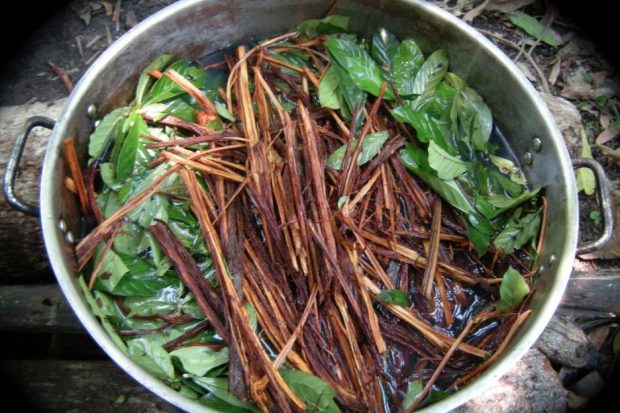
Ayahuasca (Yagé) Colombia Legal Status
http://www.bialabate.net/news/legal-status-of-ayahuasca-yage-in-colombia-some-considerations-from-three-primary-sources
Leonardo Rodríguez-Pérez
Research Associate Pierre du Bois Foundation for Current History
Abstract
This paper discusses the legal situation of ayahuasca in Colombia. This country does not have any particular legislation to regulate ayahuasca consumption and trade. In the absence of such rules, the author argues that Colombian authorities indirectly apply regulations related to the recognition of indigenous people’s rights, which generates some legal ambiguity. He adds to the discussion by presenting three new sources: certificates of “traditional healer” given by the local indigenous authorities to three different taitas (ayahuasca indigenous or mestizo shamans). The implications of this sort of document remain to be seen. The paper also refers to national and international policies of cultural heritage. The author points out the Colombian Ministry of Culture (2010) and UNESCO (2011) both nominated “Yuruparí,” a ritual which involves the consumption of ayahuasca, for recognition as intangible heritage. And he speculates whether the recognition of Yuruparí as cultural heritage would imply that ayahuasca could be considered cultural heritage of humankind.
So far, there are no studies specifically about the legal situation of ayahuasca the consumption and trade in Colombia, unlike the cases of Brazil, Europe and the United States. This text aims to introduce three primary sources on the subject in the hope of their encouraging the development of research in the field.
In Colombia, the legislation indirectly applied to the consumption and trade of ayahuasca is the one concerning indigenous peoples; this is due to the absence of legislation directly addressing ayahuasca. For this reason, the sources presented here have been produced by indigenous authorities. The first of these sources is a certificate from the traditional administration of a Kamëntsá indigenous comunity, located near the town of Santiago de Sibundoy. Alongside Mocoa, Santiago (situated in the department of Putumayo, the gateway to the Colombian Amazon) is one of the urban centers where Colombians and foreigners go in pursuit of Ayahuasca.
The beneficiary of the certificate is the taita Juan Mutumbajoy Jacanamijoy, who has a healing center called “Wairasacha” in Sibundoy, high Putumayo. The authority issuing the certificate is a cabildo, an administrative entity imposed by the Spanish in the “Indian Republics”. This entity was appropriated by indigenous organizations during the twentieth century. Today, it is one of the institutional foundations that allows for the exercise of the right of indigenous peoples in Colombia to internal self-determination.
The document issued by the cabildo cites ILO Convention 169, the international instrument which most strongly binds the states in respecting indigenous rights, adopted by domestic legislation. The Colombian law 89 of 1890 is also cited, in force with revisions to this day. This law was part of a strategy in line with forcefully assimilating indigenous policies for much of the twentieth century. Despite its problems, the law recognizes the authority of cabildos within indigenous communities and that is why since the 1970s, it has been used by indigenous activists from Colombia to recognize their rights. Other norms listed in the certificate are the law 21 of 1991, which adopted the Convention 169 on Colombian legislation, article 7 of the National Constitution, which recognizes the multiethnic and multicultural Colombian national project and finally, law 291 of 2001, which regulates the participation of “ethnic groups” in the Colombian social security system.
The second and third documents presented here (1 and 2) are two traditional medical IDs, also granted by an indigenous authority. In this case, the documents were issued by the “Organization of Indigenous Peoples of the Colombian Amazon”(OPIAC), which, according to its official site, represents the Colombian departments of Amazonas, Caquetá, Guaviare, Guanía, Putumayo and Vaupés (i.e. all of the Colombian Amazon). Since in this case the issuing authority is not a cabildo, other norms are cited to reinforce the validity of the traditional medical IDs. First, we have the founding act of OPIAC, signed in June 1995 by representatives of various Amazon organizations. Second, we have the legal recognition that Colombia granted the OPIAC in September of the same year, by a resolution of the General Division of Indian Affairs (DGAI), whose equivalent in Brazil would be the Fundação Nacional do Indio (FUNDI).
These IDs belong to a couple of traditional healers who run an ayahuasca center outside Mocoa called Ornoyaco (which is also the name of a neighboring waterfall, known as a tourist attraction in the region). The waterfall was redesignated as a “sacred place” home of taitas and animals that inhabit non-physical realities. Taita Gregorio Castro and his wife Carmen Chindoy-Garreta also perform regular circuits around Colombia and Venezuela. Both taita Gregorio and his wife have obtained these IDs as Inga traditional healers; Inga is the indigenous people which Carmenza Garreta-Chindoy belongs to by birth as does her husband by adoption. Gregorio Castro also often claims a Cofán inheritance, because his main master, taita Querubín Queta, belongs to that people.
Both documents presented in this paper, can be requested by a police or military authority when healers transport ayahuasca from the production centers in the Amazon to the cities. Since many of these healers are not indigenous and have no ties with indigenous community authorities, it is common to see a division of labor where some individuals produce the brew (the so-called “cookers”), others transport the brew and finally others distribute it in the cities; in this way, they skip state controls. Although there is no official regulation, there are reports of confiscation of medicine by the Colombian authorities if people are transporting ayahuasca without an authorization from a cabildo or any other indigenous organization.
So far, there is no legislation explicitly addressing the subject of ayahuasca trade and consumption in Colombia. Therefore, the topic is included within the broader issue of indigenous peoples. For now, there are no actors in Colombia willing to develop legislation on ayahuasca from the point of view of religious freedom, as is the case in Brazil and abroad. Within the framework of ethnicity issues, we can only mention the existence of an international instrument indirectly related with legislation on ayahuasca. This is the recent declaration made by UNESCO on the traditional knowledge of the Yuruparí jaguar shamans as intangible heritage of humanity; the same declaration has been also made by the Colombian government.
The Yurupari is a ceremony of utmost importance among the various peoples belonging to the tukano oriental language family (Macuna, Barasano, Eduria, Tatuyo, Tuyuca, Itana and Carapana) inhabiting the Vaupés department in Colombia. The anthropologist Reichel-Dolmatoff devoted an entire book to the subject (1996), as well as analyses elsewhere in his work. In 2010, the Colombian State recognized Yurupari as an intangible cultural heritage of the nation (see original petition here).The following year, in 2011, UNESCO recognized the Yurupari as an intangible heritage of humanity. Now, the ayahuasca is a central element of Yurupari. As such, it is mentioned in the text of UNESCO and also on the website of the Colombian Ministry of Culture. Since the nomination as an intangible heritage is applied to the whole cultural ensemble, perhaps ayahuasca could be considered within the denomination of intangible heritage. In that case, we could compare the Colombian case to the Peruvian case, where knowledge of ayahuasca is considered to be an intangible heritage within an ethnic context. However, there is no explicit intention of making ayahuasca itself an element of intangible heritage in the Colombian nation. It should be further noted that Colombia abstained to vote and has not ratified the Declaration on the Rights of Indigenous Peoples by the UN in 2007, in which Articles 24 and 31 deal with medicinal plants.
Consequently, we can say that Colombia has a legal vacuum regarding the ayahuasca issue. Maybe one way of commencing working on the juridical domain of ayahuasca in Colombia is to collect documents and review practices and initiatives that have been taken so far, concerning the regulation of consumption and distribution of Ayahuasca. We hope that the available sources can contribute to such a process, perhaps inviting researchers to share their findings and thus constituting a public archive on the net.
Documents
Certificates from indigenous organisations
I thank the lawyer Alexis Kaiser from Switzerland for the copy of the first document presented here. I also express my gratitude to Gregorio Castro and Carmen Garreta-Chindoy for providing me a copy of their traditional healers IDs.
- Certificate from the traditional administration of a Kamëntsá indigenous community, june 2012
3. Carmenza Chindoy-Garreta traditional healer ID.
International instruments
C169 – Indigenous and Tribal Peoples Convention, 1989 (No. 169).
United Nations Declaration on the Rights of Indigenous Peoples (2007).
UNESCO. Nomination File n. 00574 for Inscription on the Representative List of the Intangible Cultural Heritage of Humanity in 2011.
Colombian laws and other regulations
Article 7 of the Constitution. The State recognizes and protects the ethnic and cultural diversity of the Colombian nation.
Law 89 of 1890. Determines “how savages should be governed and reduced to civilized life”.
Law 21 of 1991. Includes in domestic legislation the Convention No. 169 concerning Indigenous and Tribal Peoples in Independent Countries, adopted by the 76th. session of the ILO General Conference, Geneva 1989.
Law 691 of 2001. Regulates the participation of “ethnic groups” in the Colombian social security system.
Juridical recognition number 004 from September 1995, issued by the -DGAI for OPIAC.
Special Plan for the Safegarding of Yurupari Jaguars traditional knowledge – Colombian National Council of Cultural Heritage(2010).
Websites
Empresa Comunitaria Wairasacha de Tamabioy
http://taitajuan.wix.com/casa-del-saber#
(Last visit 09-11-2012)
OPIAC
http://www.opiac.org.co/index.php
(Last visit 09-11-2012)
Taita Gregorio Castro
http://www.facebook.com/yage.bucaramanga
(Last visit, 09-11-2012)
Traditional Knowledge Pira-Paraná included in the Representative List of the National Intangible Cultural Heritage.
http://www.mincultura.gov.co/?idcategoria=38867
(Last visit 09-11-2012)
Book
REICHEL-DOLMATOFF, Gerardo. Yurupari: Studies of an Amazonian Foundation Myth. Cambrige: Center for the Study of World Religions of Harvard Divinity School, 1996.
I thank the anthropologist Beatriz Labate for her accurate comments and editorial work on this paper.

